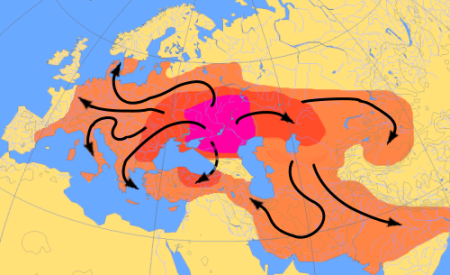 |
This is a file from the Wikimedia Commons. Information from its description page there is shown below.
Commons is a freely licensed media file repository. You can help.
|
 |
Permission is granted to copy, distribute and/or modify this document under the terms of the GNU Free Documentation License, Version 1.2 or any later version published by the Free Software Foundation; with no Invariant Sections, no Front-Cover Texts, and no Back-Cover Texts. A copy of the license is included in the section entitled GNU Free Documentation License. http://www.gnu.org/copyleft/fdl.htmlGFDLGNU Free Documentation Licensetruetrue
|
Indo-European expansion 4000–1000 BC, according to the Kurgan hypothesis.
Even within the Kurgan hypothesis, there is considerable uncertainty, mainly depending on assumptions about the w:Tocharians, the w:Corded ware culture and the w:Beaker culture.
The central purple area is supposed to show early w:Yamna culture (4000–3500 BC); the dark red area could show expansion to about 2500 BC, and the lighter red area expansion to about 1000 BC.
File usage
The following pages on Schools Wikipedia link to this image (list may be incomplete):
SOS Children's Villages aims to make Wikipedia suitable for young learners. SOS Childrens Villages is an international children's charity, providing a good home and loving family to thousands of children who have lost their parents. We also work with communities to help vulnerable families stay together and raise children in the best possible environment. Sponsoring a child is a great way to help children who need your support.



